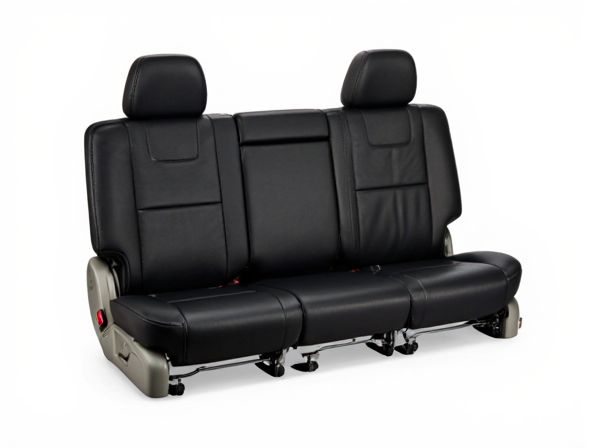
Photo illustration: Memory Seat vs Non-Memory Seat
A memory seat enhances comfort and convenience by allowing you to save and recall personalized seating positions at the push of a button, ideal for multiple drivers or frequent adjustments. Non-memory seats require manual repositioning each time, which can be time-consuming and less precise. Choosing a memory seat improves your driving experience by ensuring optimal comfort and quick adjustments tailored to your preferences.
Table of Comparison
| Feature | Memory Seat | Non-Memory Seat |
|---|---|---|
| Seat Position Recall | Stores multiple driver seat positions for quick recall | No position storage; manual adjustment each time |
| Convenience | High - automatic adjustment for multiple users | Low - requires manual settings for every use |
| Adjustment Type | Power-adjusted with memory function | Manual or power-adjusted without memory |
| Cost | Higher due to added technology | Lower, basic seat feature |
| Ideal For | Multiple drivers sharing one vehicle | Single driver or basic use |
Introduction to Memory Seats vs Non-Memory Seats
Memory seats offer customizable settings that save multiple users' preferred seat positions, enhancing comfort and convenience through electronic controls. Non-memory seats require manual adjustment each time, lacking personalized presets and relying on mechanical levers or knobs. The choice impacts user experience with memory seats providing efficiency and ease, especially in vehicles shared by multiple drivers.
What Are Memory Seats?
Memory seats are advanced automotive seating systems equipped with programmable settings that store and recall personalized seat positions for multiple drivers. These systems use electronic controls to adjust seat height, lumbar support, and backrest angle, enhancing comfort and convenience. Non-memory seats lack this feature, requiring manual readjustment each time the driver changes.
How Do Non-Memory Seats Work?
Non-memory seats operate through manual adjustments or basic electric controls that allow drivers to set their preferred seating positions without storing these settings for future use. These seats require the driver to readjust seating each time, as there is no system to recall previously saved positions. The absence of memory functionality simplifies the mechanism, often resulting in lower cost and fewer electronic components compared to memory-equipped seats.
Key Differences Between Memory and Non-Memory Seats
Memory seats store personalized seating positions including lumbar support, seat height, and mirror angles for multiple drivers, enhancing comfort and convenience during vehicle use. Non-memory seats require manual adjustment each time, lacking the ability to save and recall preferred settings, which can be less efficient for shared vehicles. The key difference lies in customization retention, where memory seats improve user experience by offering quick, automated seat configuration restoration.
Advantages of Memory Seats
Memory seats provide personalized comfort by automatically adjusting to preset positions for multiple drivers, enhancing convenience and reducing setup time. These seats often include programmable settings for seat height, lumbar support, and mirror alignment, promoting ergonomic support and reducing fatigue during long drives. The technology increases vehicle resale value and driver satisfaction by offering a tailored driving experience unmatched by non-memory seats.
Drawbacks of Memory Seats
Memory seats offer convenience by automatically adjusting to preset positions, but they come with several drawbacks. They tend to increase vehicle cost and complexity, leading to higher maintenance and repair expenses. Additionally, memory seat systems can occasionally malfunction or lose settings, causing inconvenience and inconsistent comfort for drivers.
Benefits of Non-Memory Seats
Non-memory seats offer simplicity and cost-effectiveness by eliminating complex electronic adjustments and memory settings, reducing potential maintenance issues. They provide straightforward manual or basic electric seat adjustments, ideal for drivers who prefer direct control without digital customization. This simplicity often results in quicker seat adjustments, making non-memory seats practical for vehicles shared among multiple drivers with varying preferences.
Considerations for Choosing Between Memory and Non-Memory Seats
Choosing between memory and non-memory seats involves evaluating convenience, personalization, and budget. Memory seats offer programmable settings for multiple drivers, enhancing comfort and reducing adjustments, ideal for shared vehicles. Non-memory seats, typically more affordable, suit single-driver cars or those prioritizing simplicity over advanced features.
Cost Comparison: Memory vs Non-Memory Seats
Memory seats typically cost between $500 and $1,200 more than non-memory seats due to the added electronic components and programming. Installation and repair expenses for memory seats are also higher, reflecting their complexity compared to manual or standard power seat mechanisms. Buyers should factor in these increased costs when deciding between comfort convenience and budget constraints.
Which Seat Type Is Best for You?
Memory seats offer personalized comfort by allowing multiple drivers to save and recall preferred seating positions, ideal for households with multiple users or frequent driver changes. Non-memory seats provide a simpler, manual or basic electric adjustment without saved settings, often preferred for single drivers seeking cost-effectiveness. Choosing between memory and non-memory seats depends on your daily driving habits, budget, and the importance of convenience in seat adjustment.
 caratoz.com
caratoz.com